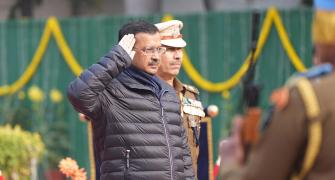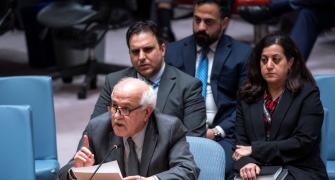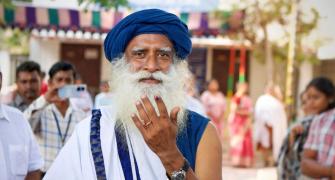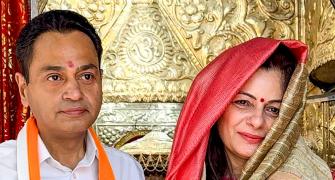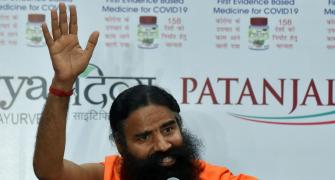Many other Indians saw their future take a different course after the tragedy. They nursed the wounded, aided the victims' families and helped the the US government in the aftermath.
A father remembers the son he lost
To mark the fifth anniversary of 9/11, rediff.com brings to you the stories of some of those Indians for whom September 11, 2001 changed their lives forever.
The men who were wrongfully charged
Today: He sifted through the wreckage.
It took three years, $16 million (approximately Rs 75.2 crores), an 85-member staff and a plethora of outside experts drawn from various US government departments to put together a 10,000-page report on the defining tragedy of our times -- and yet, Dr Shivraj Shyam Sunder's work is not done yet.
The lead investigator into the collapse of the Twin Towers, whose first report was organised in 43 chapters and made 30 specific recommendations, says he is still probing the mysterious destruction of World Trade Center 7 (next to the Twin Towers).
"I hope to complete that investigation by early next year," Sunder, deputy director of the Buildings and Fire Research Laboratory, part of the National Institute of Standards and Technology in Gaithersburg, Maryland, said.
WTC 7 is perhaps an even more complex, even more bizarre case than the collapse of the Twin Towers. A bronze-coloured skyscraper that towered 600 feet above street level and was trapezoidal in shape, WTC 7 sprawled over an entire city block and, at the time of the tragedy, housed US government offices such as those of the Internal Revenue Service (the American version of India's income tax department), the Secret Service (the American version of the Special Protection Group) and the Securities and Exchange Commission (the American version of SEBI).
It also housed, on the 23rd floor, then New York mayor Rudi Giuliani's Office of Emergency Management and the related command centre, set up in the aftermath of the WTC bombing of 1993, and outfitted, at the cost of millions of dollars, with bullet and bomb-resistant windows.
The building was not struck by either of the planes but, officials say, was destroyed by the fires that resulted from the WTC attack. Sunder and his team are yet to fully probe the many mysteries behind the destruction of WTC 7, but his completed probe into the collapse of the Twin Towers has, he says, yielded quite a few action points.
While his working title is that of lead investigator into the WTC disaster, Sunder is at pains to point out that his role is not that of a detective. "My inquiry was not aimed at finding fault with something," he says. "The idea was to find out what actually happened, and what we can do in future to prevent such tragedies."
Sunder's recommendations are currently being considered by organisations in the private and public sectors in the US, and hearings have been scheduled to consider adding these recommendations to the building code.
Meanwhile, he adds, "The UAE and Hong Kong have already accepted the recommendations, and have stipulated that tall buildings should conform to the standards we have put forward in our report."
If and when his recommendations become standard, it will drive the cost of construction up -- the amount of increase, he says, will depend on what result each individual builder, and building, is trying to achieve.
"They will not be very burdensome as the increase will be only in single digits," Sunder says. "But if we have to take steps to face eventualities like terrorist attacks, the cost will go up by several points."
There is, he points out, no realistic way to make tall buildings totally immune to an attack by say a hijacked airliner -- the real trick is to make them safer and more capable of dealing with the aftermath.
"The aim is to provide, enhance safety measures; to provide for easier and safer evacuation procedures in the event of some disaster," he says.
One of his key recommendations relates to the need to improve fireproofing. He says that on the basis of his investigations, he has come to admire the structure, the construction, of the World Trade Centre -- but he believes that the towers would not have collapsed if the fireproofing material surrounding the steel had not been stripped away by the impact of the planes.
The heat generated when the planes hit the Twin Towers and exploded was, he says, intense, going up to 800 degrees Fahrenheit or more -- but that factor would not of itself have melted the steel and collapsed the towers; what made the difference, he believes, was that the fireproofing sheath was not able to stick to the outside of the steel facade at such high temperatures.
There are, he says, other, better ways to layer the fireproofing to ensure that it adheres better to steel.
It is a seemingly small point but in fact is key, Sunder points out. He notes, on the basis of his investigation, that the jet fuel in the planes likely burnt out in less than 10 minutes. "What did burn over the next hour, or hour and a half, was much of the contents of the buildings," he says.
Sunder dismisses the contention floated in some quarters that lower grade steel was used in the construction of the Twin Towers -- on the contrary, he says, the quality of steel was at least 10 to 15 per cent better than the requirement. He adds, further, that the WTC complied with all known standards of the era and in several cases, exceeded existing stipulations.
Steel, he pointed out, does not melt -- what happens at high heat is more a softening and, hence, the inability to support itself and the structure. "What happened here was something unimaginable," he says.
It is not mere theorising -- over the three years of his probe, Sunder and his team conducted endless tests, using both models and computer simulation.
A parallel focus of his probe sought explanations for the number of lives lost, and solutions to prevent similar disasters. The key, Sunder says, lies in evacuation capabilities -- the WTC just did not have what it took to evacuate an entire building in limited time.
Sunder's report reveals that in the North Tower, for instance, stairwells are close to one another -- hence, if one is affected, chances are the other will be too.
The report recommends that special elevators and stairwells, capable of withstanding fire and smoke, be incorporated into the design of skyscrapers; that their locations be carefully plotted to ensure easy access; that stairwell capacity and door width be adequate to cope not only with the traffic, but also to allow for emergency access by responders.
The devil, he adds, invariably lies in the details -- for instance, having a sprinkler system is half the story, the key is in how it is set up. For instance, in the North Tower, only one point was connected to the sprinkler grid; when that point was affected, the entire sprinkler system failed.
Sunder declines to extrapolate, to comment on whether his research indicates potential problems in other landmark skyscrapers across the United States such as, for instance, Chicago's famed Sears Tower.
"Our inquiry focused on the WTC," he says. "Each building is different -- it is not possible to use data obtained from one to analyse another."
Yet, he professes overall satisfaction with the safety standards of existing buildings and, more importantly, of those that have begun construction after the tragedy.
His appointment as lead investigator was a high point in his career, but not necessarily an unmixed blessing. "It was highly visible," he says of the appointment. "Everybody was watching the investigation -- the families of the victims, the US government, US Congress, the building industry in the US and other countries."
Given that intense scrutiny, the probe had to be more than ordinarily thorough -- it took months, he says, to create models that could in miniature replicate the Twin Towers, and subject them to experiments designed to figure out what happened and why.
It was not all scientific theorising and experimenting -- a meticulous analysis of human behaviour was an integral part of the inquiry. "We conducted more than 1,000 interviews with those who escaped, and with those who went to help the victims. More than 150 emergency workers were also interviewed.
"We were thus able to determine in considerable detail what occurred after the planes hit, and before the towers collapsed."
This part of the probe was the most crucial. The towers, he says, could at full capacity hold 40,000 people; the norm though is for it to be half full at any given point. Had that many people been present at the time of the attack, he adds, the toll would have been closer to 14,000.
What is interesting, he says, is that approximately half the deaths occurred on the floors above where the planes struck, and thus could be directly attributed to the air strikes themselves -- but the other half occurred on the lower floors, and could be traced to the inadequate stairways, that challenged the efforts of rescuers attempting to move that many people that quickly.
In the North Tower, he says, the average survivor took 48 seconds to descend a flight of stairs -- that is about half the slowest evacuation speed calculated in a current fire safety handbook used by engineers in designing buildings.
Communication is another key -- there was, says Sunder, no timely exchange of information between various agencies. Some fire fighters testified, he adds, that they would have gotten better information from watching television, than they were given at the scene.
Thus, a foolproof communications system forms part of his recommendations -- one capable of constantly updating information from various floors, and putting first responders in direct touch with the victims, and with one another.
It would likely be interesting to think in terms of designing tall buildings to withstand any and all forms of terrorist attacks -- but, warns Sunder, the cost would be prohibitive; hence his insistence on a broad-based menu of procedures that, while attending to little details like better fireproofing and enhanced sprinkler systems, focuses on ensuring minimum loss of life in the event of an incident.
At a personal level, the probe has impacted on his life in unimagined ways. The hours were endless, weekends blurred into weekdays and the family unit felt the strain. "My wife and daughter stood with me," he says.
On a more positive note, he has during this period moved another rung up the professional ladder -- Sunder, who joined BFRL in 1994 as manager in the newly created high performance construction materials and systems programme, has now been elevated to acting director.
The probe, and the expertise derived as a result, have made him much sought after by organisations and governments around the world. For instance, the Chennai-born Sunder travelled to India in 2003 and, among other items on his schedule, gave a presentation to the students of IIT-Madras.
But the real changes have come in terms of his outlook on his work, on life, on the world in general. "I met several family members of the victims," Sunder recalls. "Each had his own story, his special sadness and sense of loss. It was heart wrenching."
Buildings could become safer as a result of his activities; the human scars, he reckons, will never be fully erased.

